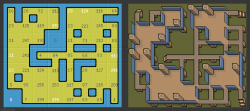Wang ‘Blob’ Tileset
Wang ‘Blob’ Tileset
This is a template layout for a 47 tile ‘Blob’ tileset, packed into a 7x8 array. This is one row less than the template here. The 9 duplicate tiles, are indicated by white index numbers.
Each index number is calculated by adding up binary weightings (1, 2, 4, 8, 16, 32, 64, 128) for yellow edges or corners in a clockwise direction from the top edge.
A complete tileset would therefore require 2^8 = 256 tiles. The advantage of ‘Blob’ tilesets is that just 47 tiles are needed to seamlessly cover floor or rug-like areas.
From the template I created a ‘raised platforms and walkways’ tileset. The isometric pixel art gives an idea of how the tiles fit together to create seamless random maze-like designs.
Visit my webpage to create more random layouts (select ‘Commune’ from the Blob pull-down menu). There is also explanation of Wang tile maths and two different Blob tile construction methods.
Also found a web page explaining Blob tilesets here.









Comments
For the record, those tiles aren't isometric but obliquely projected. It is a neat and underused projection, especially in recent times. Good job!
Yes, you are quite right, thanks for the correction.
I find 'oblique' the easiest projection to draw, even if some of the shadows end up a bit odd.
That's some nice Wang.
Some of the more complex tilesets look like they would be fun to explore as a 2D grid of 3D tiles, or maybe as a fully 3D tesselation.
You can extend Wang methods into 3D, using cubes instead of flat tiles. Cubes have 6 faces instead of a tiles 4 edges so you end up with 64 cubes in a complete ‘cubeset’. They should all fit together facelessly?? But you’ll need a 3D renderer to see the results - Unity web page plug in perhaps. All the extra complexity may not be worth the effort.
But certainly some of the tilesets could be recreated in a 3D game.
Maybe a maze generator plug-in for Minecraft is needed which can create ‘bridge over trench’ paths not just a flat ‘hedge maze’.
For some carzy reasons this cually makes sence to me , one would imagine how could it would be to make a 3D room with anmses like that as walls froor and celing.
Yep - it could be fun
There are real 3d mazes, usually made of wood, at some theme parks and places where you can wander around a physical layout. Problem is they can get boring for grown ups. Being 'in' a maze is quite a different experience than looking down on one.
Note: I've updated the above maze image, now includes better shadows. Also added the tileset to cr31 [Stage]. This is a Twin maze not a Blob maze. Select 'Brench' from the Twin Maze pull down menu to see random layouts.
I see your website (subpage wang/blob.html) still states
"We can pack the complete tileset into an 7x8 array. I'm fairly certain a smaller 7x7 array is not possible."
So let me mention http://opengameart.org/content/seamless-tileset-template-ii
Thanks for the shout. I really thought I had the minimum layout worked out. Quite amazing. I’ve updated the cr31 ‘Blob’ page and added a link to you.
Here is your 7x7 layout using the commune 'Blob' tileset:
Hey!
This may be a silly question, but could you explain how the layouts are being made after the Indices are calculated?
How are you using the property of the index to create the tile set (what the neighbouring tiles should be and where the randomization happens), maybe with respect to the below arrangment.
5 -- 95
| |
0 -- 7
I can't seem to find an explaination to that. If you have a link explaining, do send me that.
Thanks.
Hi
Once the indices are calculated the job is done and all tile edges and corners should (in theory) match up !!
Not too sure I follow your 5_95_0_7 arrangement. This is the bottom left of a fixed tilemap layout. But see the explanation here (at my cr31 site) for generating random 'Blob' layouts by either Method 1 or Method 2.
The large random layout image is actually generated by a third Method 3. A simple orthogonal (no diagonals) maze is created and as the path progresses, rooms (or islands) are filled in. This ensures all rooms are connected. See here (bottom of page) for a fuller explanation.
An advantage of maze generation is that it can be adjusted to create a few long winding or many short stubby paths leading to different balance of rooms, paths and general meandering.
You can try it out here. Choose a Blob tileset and then click on 'Maze' (instead of 'Random') and watch it go to work. Mazes can be any size but the outer stage edge is always 0.
Also the generator never merges paths together (perfect maze only) so there is always one unique path between any two tiles. I might add in some further controls to allow for path merging.
Hope the links help. I'll tidy up some cr31 texts to make things clearer. Let me know if you need more info. Thanks, Guy.